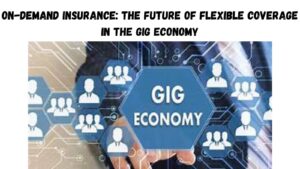The world of auto insurance is undergoing a massive transformation. Insurance policies used to rely on fixed factors such as age, gender, and driving history. Telematics and artificial intelligence (AI) are changing auto insurance. Now, offerings are becoming more dynamic and personalized. These technologies enable usage-based insurance (UBI). With UBI, drivers pay premiums based on how, when, and where they drive. This approach moves away from using just demographic data.
In this exploration, we’ll look at how telematics and AI are changing auto insurance. We’ll discuss real-time data and how these shifts are making insurance more personal and fair for consumers. We’ll look at real-world examples, provide data-backed insights, and touch on the future of this rapidly evolving space.

What is Telematics and How Does It Work in Auto Insurance?
Contents
- 1 What is Telematics and How Does It Work in Auto Insurance?
- 2 Telematics and Auto Insurance: The Shift Toward Usage-Based Insurance (UBI)
- 3 The Role of AI in Auto Insurance: Personalized, Data-Driven Decision-Making
- 4 How Smart Devices and Real-Time Data Are Personalizing Auto Insurance
- 5 The Benefits of Telematics and AI in Auto Insurance
- 6 Fun Facts About Telematics and Auto Insurance
- 7 Challenges and Concerns with Telematics and AI in Auto Insurance
- 8 Conclusion
- 9 FAQs on Telematics and AI in Auto Insurance
- 10 How does telematics impact my auto insurance premium?
- 11 Is telematics data used to track my location all the time?
- 12 Can I save money with usage-based insurance (UBI)?
- 13 Are there any privacy concerns with telematics data?
- 14 Does AI improve the accuracy of claims processing?
Telematics refers to the integration of telecommunications and monitoring technologies in vehicles. Telematics systems use GPS and in-car sensors to track driver behavior in real-time. This gives valuable insights into their driving habits. This includes data on speed, braking patterns, acceleration, and even time of day.
Telematics and Auto Insurance: The Shift Toward Usage-Based Insurance (UBI)
In the context of auto insurance, telematics devices offer a goldmine of data that can be used to determine a driver’s risk profile. Usage-based insurance (UBI) differs from traditional models. Instead of relying on broad demographic data, UBI uses real-time data. This approach helps provide more accurate and personalized premiums.
Real-Time Examples:
- Progressive Snapshot: Progressive’s Snapshot program stands out as a key example of telematics-based insurance. The device plugs into a car’s OBD-II (On-Board Diagnostics) port, tracking driving behaviors like speed, braking, and mileage. Progressive gives discounts to safe drivers. But drivers with riskier habits might pay more.
- Allstate’s Drivewise: Allstate uses telematics to give personalized discounts to drivers with its Drivewise program. Users receive rewards for safe driving and can track their driving behavior through the mobile app. Allstate uses this data to adjust premiums and encourage safer driving habits.
The Role of AI in Auto Insurance: Personalized, Data-Driven Decision-Making
Artificial intelligence (AI) is playing a crucial role in the future of auto insurance. AI algorithms can process vast amounts of data far more quickly and efficiently than humans. AI can analyze telematics data with other factors, like weather and traffic. This helps insurers build better risk profiles and provide personalized premiums.
AI’s Impact on Risk Assessment and Claims Processing
- Risk Assessment: Insurers used age, gender, and driving history to evaluate risk. AI allows insurers to look at factors like driving style, route, and time of day. This helps them set premiums more accurately and fairly. A driver who drives safely in heavy traffic may be judged differently than someone who drives aggressively on country roads.
- Claims Processing: AI is also making claims processing faster and more efficient. AI chatbots can manage first-contact claims. Image recognition tech helps assess vehicle damage from customer-uploaded photos. This automation can drastically reduce the time it takes to settle a claim, improving customer satisfaction.
How Smart Devices and Real-Time Data Are Personalizing Auto Insurance
Telematics and AI help insurers provide personalized coverage. This coverage adjusts based on each person’s driving habits. Here are some ways this data is changing the landscape:
- Pay-Per-Mile Insurance: Telematics devices track your driving. This lets insurance companies offer pay-per-mile or usage-based plans. This model helps drivers who don’t use their cars often. They pay only for the miles they drive, not a flat rate based on old demographic data.
- Behavioral Discounts: Many insurance companies reward safe drivers with discounts. They base these discounts on data from telematics devices. Safe driving habits, such as smooth acceleration and braking, can lower your insurance costs. Staying within speed limits also helps save money on premiums.
- Real-Time Risk Adjustment: AI systems can change premiums instantly. They do this by tracking shifts in driving behavior or risk factors. If a driver starts making riskier choices, like speeding or driving at night, the insurer can raise their premiums to match the higher risk.
- Contextual and Dynamic Pricing: Insurance premiums can change based on the time of day, traffic, or weather. For example, a driver might be charged more during peak traffic hours or during rainy weather when the risk of accidents is higher. This dynamic pricing model provides a more accurate reflection of real-world risks.
Example:
- Metromile: Metromile offers a pay-per-mile insurance model where users pay for the actual miles they drive. Their telematics device collects driving data, and premiums are calculated based on how much the customer drives. This is ideal for people who use their cars only occasionally.
The Benefits of Telematics and AI in Auto Insurance
The integration of telematics and AI into auto insurance offers a wide range of benefits, not just for insurers, but also for consumers. Some of the key advantages include:
- Better Risk Assessment: Real-time data helps insurers evaluate individual risk factors. This leads to personalized premiums and may lower costs for safe drivers.
- Lower Fraud: AI and telematics can cut fraud. They spot mismatches in claims. For example, when a driver’s actions don’t align with their telematics data.
- Increased Safety: Telematics systems give drivers feedback on their habits. This helps them drive safer. As a result, accidents and claims go down.
- Lower Premiums for Low-Mileage Drivers: If you don’t drive much or stick to safe roads, UBI can help you save money. You’ll pay only for the coverage you need.
Fun Facts About Telematics and Auto Insurance
- The Global Telematics Market Is Booming: The telematics market for cars is set to surpass $60 billion by 2027. This growth comes from the rising use of UBI programs.
- A Driver’s Behavior Can Save Big Money: Safe drivers may save up to 30% on their premiums with telematics discounts from some insurance providers.
- AI Can Predict Accidents Before They Happen: AI analyzes driving habits, road conditions, and driver fatigue. This helps predict accidents. Insurers can then give personalized safety tips.
Challenges and Concerns with Telematics and AI in Auto Insurance
While telematics and AI offer many benefits, there are also some concerns that need to be addressed:
- Privacy Concerns: Some drivers are wary of the amount of personal data being collected by telematics devices. Insurers must ensure that this data is handled securely and in compliance with privacy regulations.
- Access to Technology: Some drivers lack the latest telematics devices or smartphones for AI apps. This gap can lead to unequal savings and insurance coverage.
- Data Accuracy: The accuracy of telematics data is crucial. If the device or app collects erroneous data, it could lead to incorrect premium pricing or claims denial.
Conclusion
Telematics and AI are changing auto insurance. They make it more personal, fair, and efficient. Insurers can use real-time data to set premiums based on actual driving behavior. This is better than relying on general demographic categories. This helps consumers and also lets insurers cut risk, boost efficiency, and promote safer driving.
As technology continues to evolve, it’s clear that the future of auto insurance will be shaped by these innovations. Usage-based insurance is the future. It uses telematics and AI for smarter, tailored coverage. Both insurers and consumers must tackle challenges like data privacy and tech access. This way, everyone can benefit from these advancements.
What is InsurTech? How Technology is Transforming the Insurance Industry
FAQs on Telematics and AI in Auto Insurance
Telematics collects data on your driving habits, such as speed, braking, and mileage. Insurers use this data to offer personalized premiums, rewarding safe drivers with lower rates.
Is telematics data used to track my location all the time?
Telematics devices track driving data like braking and acceleration. They also monitor location, but only when the vehicle is moving. The specifics depend on the device and insurer.
Can I save money with usage-based insurance (UBI)?
Yes, if you drive safely or infrequently, UBI models like pay-per-mile insurance can lead to lower premiums.
Are there any privacy concerns with telematics data?
Insurers have to follow data protection laws. This helps keep your information safe. They can only use it for insurance purposes, despite privacy concerns.
Does AI improve the accuracy of claims processing?
Yes, AI can streamline the claims process, reducing human error and speeding up decision-making. AI can spot fraudulent claims. It does this by finding gaps between reported accidents and driving behavior data.
This overview covers telematics and AI and their impact on auto insurance. Data-driven technologies are reshaping how insurers price and manage policies. The future of auto insurance is changing fast. It focuses on personalization, fairness, and innovation. This shift is very promising.


